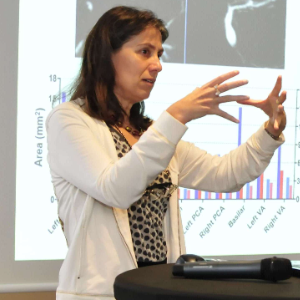Title : The defining cerebral vascular pathology of the new clinical histopathologic entity ACTA2-related cerebrovascular disease (ARCD)
Abstract:
Smooth muscle cell (SMC) contractility is essential for the function of vessels and viscera and relies on the integrity of the actin-myosin apparatus. Two tissue-specific actin isoforms, α2-smooth muscle actin (SMA), encoded by the ACTA2 gene, and α-SMA are predominantly expressed in vascular and visceral SM, respectively. ACTA2 mutations induce vascular abnormalities that lead, among other manifestations, to aortic aneurysms, coronary artery and cerebrovascular disease. A distinct variant of cerebrovascular disease has been proposed for patients with the α2-SMA R179H mutation. We present here an integrated analysis of a severely compromised adult patient succumbing from massive stroke and carrying the R179H mutation that defines the new entity of ACTA2-related cerebrovascular disease (ARCD). A second infant patient carrying this disease succumbed of pulmonary hypertension. The presence of aortic aneurysms, persistence of patent ductus arteriosus, congenital absence of iris and characteristic radiologic appearance of the internal carotid artery and its major branches are confirmed as defining clinical features. The striking underlying histologic abnormalities in both patients involved arteries of all sizes and included massive intimal SMC proliferation, elastic lamina dissection/fragmentation, disorganized media and prominent increase in vessel wall extracellular matrix, suggesting impaired function of arterial SMCs. Actin threedimensional molecular modeling revealed critical positioning of R179 at the interface between the two strands of filamentous (F)-actin and destabilization of interstrand bundling by the R179H mutation, thus explaining the severe associated phenotype. In conclusion, these characteristic clinical and pathologic findings establish ARCD as a new syndrome for which therapeutic implications are discussed.




